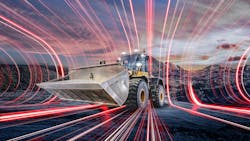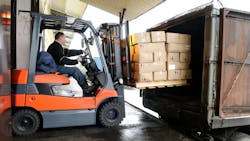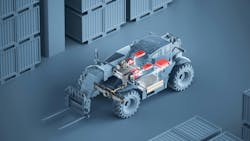Electrification Brings New Technology and Market Opportunities
What you’ll learn:
- New technology requirements for electric vehicles in the mobile equipment industry.
- Benefits that can be achieved with electrification of systems and machines.
- Future technology requirements for electrification and potential market opportunities.
As electrification increases in mobile equipment markets, from construction and agricultural equipment to forklifts and heavy-duty trucks, it is bringing about a range of technological developments.
New technologies are required as well as updates to the fluid power and other power transmission systems typically utilized on heavy-duty mobile equipment.
Regal Rexnord, for example, began developing electric braking solutions as forklifts, compact construction machinery and other mobile applications began to electrify. Silvain Fauriaux, Global Market Director – Forklift Truck and Electrical Vehicles Market at Regal Rexnord, explained during a webinar with Power & Motion (see sidebar below) that the company used to offer hydraulic solutions. However, it saw a greater need to convert from hydraulically actuated brakes to electric versions as electrification grew in the mobile applications Regal Rexnord serves.
He said use of electric braking systems offers several benefits including ease of integration into drive units and the ability to incorporate speed sensors and other electronics for performance monitoring.
Danfoss Power Solutions has also increased its development of electrification solutions for the mobile equipment sector as it has moved toward greater use of electric powertrains. These include enhancements to hydraulic components and systems to meet the energy efficiency requirements of electric machines as well as dedicated electrification technologies such as inverters and electric motors from the company’s Editron division.
Watch the Webinar to Learn More
Register for on-demand viewing our webinar "Technological Opportunities and Challenges in the Electrification Market" for more insights from our discussion with Stefan Eichler and Silvain Fauriaux. During the webinar they dive into new technology development areas, challenges related to the design of systems for electric vehicles as well as what most excites them about working in the electrification space.
This webinar is the third and final in a series of webinars covering electrification topics to help the fluid power industry better understand its role within this space. Read the following articles for excerpts from the first two webinars in the series:
How Hydraulic Systems are Evolving to Meet Electrification Requirements
Safety Factors to Consider When Working with Electrification Systems
Stefan Eichler, Senior Manager, Editron Sales, EMEA, Danfoss Power Solutions, said during the Power & Motion webinar that electrification opened up new market opportunities for Danfoss Power Solutions. For example, marine was not an area in which the company had a strong presence previously. “The marine world was niche in the beginning for us, but with electrification and our rough environment components, we are [now] a key player [for electrification] in the marine industry,” he said.
Following is an excerpt from the webinar in which Fauriaux and Eichler offer their insights on technological developments for electric vehicles as well as the opportunities they see for those working in the electrification space.
Editor’s note: Questions and responses have been edited for clarity.
Power & Motion: How has the push toward electrification influenced the design of your company’s fluid power and power transmission technologies?
Stefan Eichler: It's influencing the whole company, the established part as well as the electrification part, because electrification opened new [possibilities]. Everything started with needing zero emission vehicles — OEMs took out the diesel [engine], we call it a diesel swap, put in an electric motor and a battery, and now [we have a] very simplified zero-emission vehicle. This is how all this started.
But then, of course, you recognize that it's all about efficiency the moment you have a battery. And this is requiring different components on the hydraulics side, because we still have hydraulics in the machine. [Hydraulics] will not disappear, we'll always have hydraulics, but it [electric vehicles] needs efficient hydraulics, and it needs efficient gear drives. It needs a lot more efficiency.
[In the past], we were all happy where we were with diesel…but now with electrification this is opening a huge opportunity for us as Danfoss to use the experience we have to improve all of our products, the whole chain. Even hoses are a part of the efficiency chain; [because we develop hoses] in house, we can really work on improving the losses in the whole [system].
Silvain Fauriaux: In the past, we [Regal Rexnord] used to have hydraulic solutions in our portfolio, but we’ve seen that declining over the years. We have been focusing on electrification and on providing products which are fully electric in order to provide our customers with a clean solution [which is] easy to control, easy to implement and basically enabling them to fully replace a hydraulic solution with an electric one.
Power & Motion: What are some of the benefits your customers have seen by moving to electric solutions?
Silvain Fauriaux: Forklifts, for instance, are used everywhere but are also in areas where cleanliness is key such as cold rooms and food storage. There is no room for oil or [other] external pollutions. [In these applications] electrification has played a key role.
When you look at [compact construction] machines working in cities, emissions and noise pollution are also key factors which have pushed our customers to electrify. This has offered us a lot of opportunities to provide electric solutions.
Stefan Eichler: It's always amazing when we start designing an electric machine. [Typically] it already exists as a traditional diesel machine, then we electrify it. And the moment customers get on their vehicle the first time is the most exciting moment, because they smile from one ear to the other and say ‘I would have never expected such performance, such preciseness from an electric vehicle.’
The impact is also big for TCO (total cost of ownership) — we have many applications where we simply cut the energy demand in half by [using] electrification and optimizing the hydraulics. If the vehicle is big [and needs] a lot of energy, it's a big cost impact. There is a long list of benefits for our customers when it comes to electrified machines…they can work faster with these machines, they're much more agile, [they get] more performance and higher efficiency. That's what you can gain [with electric] machines.
Power & Motion: What further technological challenges and opportunities do you see in the years ahead for components and systems utilized in electric vehicles, and how do you see them being addressed?
Stefan Eichler: The biggest challenge is really to develop an electric machine — it can be a hybrid, it can be battery-electric, it can be cable connected — which fits the business case. We have been subsidized for many years, and now the public money is gone. So, the machine needs to have a solid business case, and this is what we need to work on. This is clearly a challenge, but this is also an opportunity because the suppliers who can cope with this and find a solution will stay in the market [and] be even stronger in the market.
Power density, [fitting technology] into a small space, uptime, making the machine reliable, long lasting and cost effective, [those are], for me, the very high-level challenges we have.
Partly, we need new technologies [to meet these requirements]. But many [technologies] are already here, we just sometimes need to industrialize these new technologies. There are new battery chemistries…and many principles for how we build electric motors; some of them can increase power density dramatically, but right now, they're even more expensive than the solution we have today. So, we have to find ways to industrialize these better solutions to achieve the technical goals but at the same time not get more expensive. We need new technologies [and] new production technologies; it's not just the technology of the product itself but also how we produce it.
Silvain Fauriaux: Electrification is targeting higher capacity machines, and for that you need to have bigger solutions. The [power capacity requirement] is so large, that we need to do a lot of research and development to provide solutions [to meet these requirements].
I think e-steering (electric steering) is something that will really be a trend moving forward. As you know, we need to improve the cost of [electric-powered] machines. We need to be more profitable. The market is demanding that. And we need to shrink the space taken up by existing solutions.
We need to improve energy [use] and bring more technology inside to improve the controllability as well as serviceability. How can you predict maintenance? This is something that is not really done as of now. We have passive products, but customers are looking for active products which provide feedback [and e-steering can help meet each of these market demands].
About the Author
Sara Jensen
Executive Editor, Power & Motion
Sara Jensen is executive editor of Power & Motion, directing expanded coverage into the modern fluid power space, as well as mechatronic and smart technologies. She has over 15 years of publishing experience. Prior to Power & Motion she spent 11 years with a trade publication for engineers of heavy-duty equipment, the last 3 of which were as the editor and brand lead. Over the course of her time in the B2B industry, Sara has gained an extensive knowledge of various heavy-duty equipment industries — including construction, agriculture, mining and on-road trucks —along with the systems and market trends which impact them such as fluid power and electronic motion control technologies.
You can follow Sara and Power & Motion via the following social media handles:
X (formerly Twitter): @TechnlgyEditor and @PowerMotionTech
LinkedIn: @SaraJensen and @Power&Motion
Facebook: @PowerMotionTech

Leaders relevant to this article:




